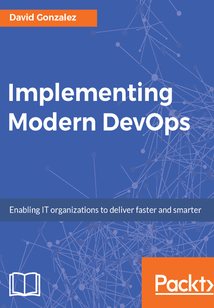舉報 

會員
Implementing Modern DevOps
最新章節(jié):
What is next?
ThisbookiswrittenforengineersandcompaniesthatwanttolearntheminimumsetofrequiredtechnologiesandprocessestobesuccessfulintheDevOpsworld.Thisbookalsotargetssystemadministrators,developers,andITprofessionalswhowouldliketoemployDevOpstechniquesandbestpracticestomanageITinfrastructuresorwouldliketoacquirethenecessaryskillsneededtoworkinDevOpsteams.
目錄(173章)
倒序
- coverpage
- Title Page
- Copyright
- Implementing Modern DevOps
- Credits
- About the Author
- About the Reviewer
- www.PacktPub.com
- Why subscribe?
- Customer Feedback
- Dedication
- Preface
- What this book covers
- What you need for this book
- Who this book is for
- Conventions
- Reader feedback
- Customer support
- Downloading the example code
- Downloading the color images of this book
- Errata
- Piracy
- Questions
- DevOps in the Real World
- What is DevOps?
- DevOps origins
- DevOps and corporations
- Traditional release management
- Chain of communication
- The cost of fixing a bug
- Releasing new versions
- Modern release management
- Agile development and communication
- Releasing new versions
- DevOps and microservices
- DevOps: Organizational alignment
- What to expect from this book
- Summary
- Cloud Data Centers - The New Reality
- Amazon Web Services
- EC2 - computing service
- Launching an instance
- Relational Database Service
- Networking in AWS and EC2
- Storage in AWS and EC2
- Amazon S3
- Amazon ECR and ECS
- Creating a cluster
- Other services
- Route 53
- CloudFront
- Amazon ElasticCache
- Amazon RDS
- DynamoDB
- Google Cloud Platform
- Google Compute Engine
- Standard machine types
- High-memory machine types
- High-CPU machine types
- Shared-core machine types
- Custom machines and GPU processing
- Launching an instance
- Networking
- Google Container Engine
- Setting up a cluster
- Other Google Cloud Platform products
- Google App Engine
- Machine Learning APIs
- Big data
- Other cloud providers
- Heroku
- DigitalOcean
- Azure
- Summary
- Docker
- Docker architecture
- Docker internals
- Docker client
- Building Docker images
- Dockerfile reference
- Docker registries
- Public registries
- Private registries
- Docker volumes
- Docker networking
- User-defined networks
- Docker Compose
- Summary
- Continuous Integration
- Software development life cycle
- Testing types
- Traditional CI servers
- Bamboo
- Jenkins
- Secrets Management
- Modern CI servers
- Drone CI
- Installing Drone
- Running builds
- Executing pipelines
- Other features
- Summary
- Infrastructure as Code
- Google Cloud Platform SDK - gcloud
- Creating resources with Google Cloud SDK
- Terraform
- Creating resources
- Remote state management
- Modifying your infrastructure
- Terraform variables
- Terraform outputs
- Summary
- Server Provisioning
- Server provision software
- Chef
- Puppet
- Ansible
- Ansible
- Ansible configuration
- Ansible variables remote facts and templates
- Ansible variables
- Ansible remote facts
- Ansible templates
- Flow control
- Roles
- Ansible Tower
- Summary
- Docker Swarm and Kubernetes - Clustering Infrastructure
- Why clustering ?
- Docker Swarm
- Kubernetes
- Kubernetes logical architecture
- Setting up a cluster in GCP
- Kubernetes building blocks
- Pods
- Deploying a pod
- Replica Sets
- Deployments
- Services
- Other Building Blocks
- Daemon Sets
- PetSets
- Jobs
- Secrets and configuration management
- Kubernetes- moving on
- Summary
- Release Management – Continuous Delivery
- Playing against the statistics
- The test system
- ISO date and UTC date services
- Aggregator service
- Pushing the images to Google Container Registry
- Setting up a continuous delivery pipeline for images
- Setting up Jenkins
- Continuous delivery for your application
- Regular release
- Blue-green deployment
- Canary deployment
- Summary
- Monitoring
- Introduction
- Types of monitoring
- Blackbox monitoring
- Whitebox monitoring
- Monitoring third-party tools
- Pingdom
- Logentries
- AppDynamics
- Stackdriver
- Monitoring applications
- Monitoring Kubernetes clusters
- Summary
- What is next? 更新時間:2021-07-08 10:11:53
推薦閱讀
- Functional Python Programming
- JavaScript 從入門到項目實踐(超值版)
- PyTorch自動駕駛視覺感知算法實戰(zhàn)
- Building a Game with Unity and Blender
- Cross-platform Desktop Application Development:Electron,Node,NW.js,and React
- Learning ArcGIS Pro 2
- 動手玩轉(zhuǎn)Scratch3.0編程:人工智能科創(chuàng)教育指南
- Java編程指南:基礎(chǔ)知識、類庫應(yīng)用及案例設(shè)計
- UI智能化與前端智能化:工程技術(shù)、實現(xiàn)方法與編程思想
- 編寫高質(zhì)量代碼:改善C程序代碼的125個建議
- C程序設(shè)計案例教程
- Oracle 18c 必須掌握的新特性:管理與實戰(zhàn)
- Android應(yīng)用案例開發(fā)大全(第二版)
- 動手學(xué)數(shù)據(jù)結(jié)構(gòu)與算法
- 新一代SDN:VMware NSX 網(wǎng)絡(luò)原理與實踐
- Elasticsearch Essentials
- Java編程從入門到精通
- 區(qū)塊鏈國產(chǎn)化實踐指南:基于Fabric 2.0
- 愛上C語言:C KISS
- Penetration Testing with the Bash shell
- Yii2 By Example
- Python無監(jiān)督學(xué)習(xí)
- C語言程序設(shè)計實驗指導(dǎo)教程
- Java實例精通
- React Components
- SignalR Blueprints
- 3ds Max 2012三維設(shè)計能力教程(第二版)
- Learning Ceph
- ODPS權(quán)威指南:阿里大數(shù)據(jù)平臺應(yīng)用開發(fā)實踐
- OpenShift在企業(yè)中的實踐:PaaS DevOps微服務(wù)

